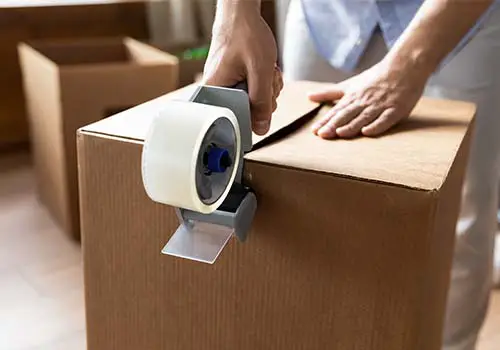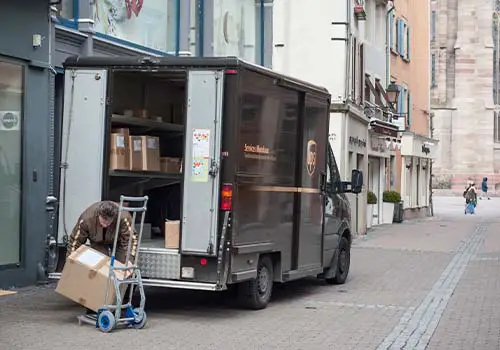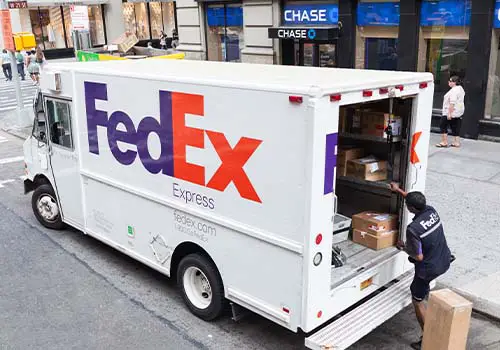Shipping Box Sizes & How To Select The Right One
Table of Contents

Shipping boxes come in all different shapes and sizes. You can even find different size boxes depending on the shipping carrier you are using. In addition to different sizes, boxes are made of many different materials. How do you select between regular cardboard boxes or corrugated boxes? Which size box is best to use for the item that you need to ship? Most people who need to ship an item are not professional shippers. It can be extremely confusing to select the right box based on the number of choices available. If you need help choosing the proper box for your shipment, then keep reading. We will give you all the details on the different sizes available as well as help you select the right material based on how strong the box needs to be.
USPS Shipping Box Sizes

The United States Postal Service offers many different boxes to meet your shipping needs. USPS will even send many of these boxes to your small business or eCommerce store at no charge! Similarly, you can pick up shipping boxes from your local post office for free. To find a full listing of USPS products that are available, simply head over to their online store on USPS.com. We will focus here on their standard boxes and flat-rate boxes.
— Standard USPS Box Sizes
USPS offers a variety of boxes that will accommodate items of different sizes, from shoeboxes to board games. USPS also offers DVD boxes and other sizes that will fit almost any item that you need to ship. These boxes are typically used for their USPS Priority Mail service. If you wish to ship something via first-class package service or some other option, then you will need to purchase your own box.
— USPS Flat Rate Boxes
The post office offers small, medium, and large flat rate boxes. The small shipping box measures approximately 9″ x 5″ X 2″ and is good for shipping brochures or small electronics. Medium boxes are available in both side-loading and top-loading options. Large shipping boxes can be used to send bigger items like laptops or office supplies. These boxes measure approximately 12″ x 12″ x 6″.
In addition to flat-rate boxes, the post office also offers many flat-rate envelope options. They offer a small envelope, legal envelope, and padded envelope. The cost to send these flat-rate items depends on the size of the box or envelope. The larger the box, the higher the cost to ship it. Shipping for the small boxes will cost you about $8 while sending the larger box will run you about $20.
UPS Shipping Box Sizes

Just like USPS, UPS also offers a variety of sizes of shipping boxes. If you sign up for a UPS business account, you can get many of these UPS Express boxes at no charge. However, don’t plan on heading down to The UPS Store and picking them up for free. Most of the boxes there are advertised as moving boxes, so you will pay for them — along with bubble wrap and any other packing materials that are placed inside your box.
— Standard UPS Box Sizes
UPS Express boxes come in several different sizes, and they are usually a little larger than the USPS Priority Mail boxes available at the post office. UPS also offers small, medium, and large choices. The small express box measures 13″ x 11″ x 2″. This is ideal for sending smaller items like computer printouts or small electronics. The large box is quite a bit bigger, measuring 18″ x 13″ x 3″. You can also find padded mailers available from UPS if that is a better option for you than a box.
— UPS Flat Rate Boxes
UPS offers five different sizes of flat-rate boxes. These range from extra-small to extra-large. Flat-rate boxes are often the cheapest way to ship a package with a carrier. A big difference when it comes to UPS flat-rate shipping is that you can still utilize this service even with a custom box. USPS and FedEx will not allow you to use a flat-rate service when providing your own box. UPS Extra-small flat-rate boxes have a volume of about 100 cubic inches, while the extra-large boxes will hold up to 1,700 cubic inches. This can be a great shipping option when sending multiple heavy items.
— UPS Specialty Boxes
Not everything that you need to ship will fit nicely into a square box. Some items are oddly shaped, and this is where UPS specialty boxes can come in handy. The UPS Express tube box is ideal for holding items that will not fit into traditional boxes. This might include blueprints, charts, maps, or posters. The tube measures 38″ x 7.5″ x 6.5″ and is perfect for sending items that are longer than most traditional boxes.
FedEx Shipping Box Sizes

FedEx and FedEx Office offer a large variety of box sizes and shapes. However, do not expect to receive these for free. They range in price anywhere from $2 to $200, depending on the size and application. Here are some of the most common boxes you might use from FedEx.
— Standard FedEx Box Sizes
If you need shipping supplies, then FedEx has you covered. They offer the largest range of box sizes for shipping of any of the major carriers. FedEx sells many basic box sizes like 8″ x 8″ x 8″ or 14″ x 14″ x 14″. They also have larger and flatter boxes for shipping clothes or other items. An example size would be 12″ x 3″ x 17 1/2″. Their standard boxes are also available in large, heavy-duty applications. For instance, their 28″ x 28″ x 28″ heavy-duty, double-wall box could be used to send heavy and bulky items. Remember, as the size of the box increases, your shipping cost is also going to increase.
— FedEx Flat Rate Boxes
FedEx offers flat-rate boxes that are similar to the other carriers out there. They offer small, medium, large, and extra-large flat-rate boxes. They offer a couple of different options in each size. The small box measures about 11″ x 1.5″ x 12″ and can be used to send smaller items like books. The extra-large box, on the other hand, measures about 12″ x 11″ x 11″ and is used for shipping bigger items like board games or small appliances.
— FedEx Specialty Boxes
FedEx has you covered no matter what type of item you need to ship. They offer the largest selection of specialty boxes of any of the major carriers. For instance, they offer a golf bag box that measures 15″ x 15″ x 48″ that can be used for shipping golf bags. They also offer a variety of flat-panel TV boxes that are used for shipping flat-screen TVs. Their two-piece telescoping boxes can even fit items up to 108″ in length. Finally, their framed art boxes are their most expensive boxes, but they can be worth it when shipping valuable art pieces. If you need to use one of these boxes, then you might also want to work with FedEx to determine the cheapest way to ship large packages.
Purchasing Shipping Boxes From Other Suppliers

Just because most carriers have boxes available does not mean that you are required to purchase boxes from them. In some cases, using a box supplied by the carrier might mean that you are required to use their 2nd day or next-day delivery service. You may find boxes cheaper through another supplier, or you might have a need for a box size that is not sold by a carrier. Most office supply stores sell shipping boxes. If you buy your own box, then you can use any shipping service that you choose. Bringing your own box allows you the flexibility to choose different shipping carriers or services each time you ship an item.
Sometimes you might also be able to find storage boxes that are cheaper than those marketed as shipping boxes. Depending on the strength necessary for your shipment, you may determine that this is a cheaper option for you. If you need heavy-duty boxes, then you may find that file boxes from the office supply store will meet your needs. It is always best to explore different options that are available to find the right size and price point for your application. Boxes can be purchased from online retailers or in person at most stores. Do your research to find the supplier that works best for you.
How Box Size Affects Shipping Costs
You should always be careful with the box size that you select because the size of the box has a direct effect on how much it will cost you to ship a package. Carriers do not use only weight when calculating the postage required for a shipment. They use both the actual weight of the package and the dimensional weight. This means that they calculate shipping charges based on the overall dimensions of the box and the physical weight. Whichever calculation comes out higher is what you will be charged to send your package.
So, imagine sending a three-pound item in a box that measures 10″ x 10″ x 10″. It might cost you $14 to send this package. However, if you place that same three-pound item into a box that measures 22″ x 22″ x 5,” the shipping charge might increase to $22 because the size of the box is so much larger. That explanation can all be boiled down to a single point — make sure that you select a box size that corresponds with the item you need to ship. Do not use a box that is significantly larger than the item. Usually, you will still save money even if you need to purchase a smaller box. The money you will save on shipping charges by using a smaller box is usually more than the cost of the box.
Determining Shipping Box Strength
For most people, shipping box strength is not a huge concern. If you are mailing a book to a friend, then most any box that you select from the shelf will be fine. There is not much concern about the book getting crushed or the box bursting due to the weight of the book. However, some shipments require attention to detail when selecting an appropriate box. There are a few different factors that are used when considering box strength, and these specifications are printed onto all corrugated shipping boxes.
The two most common things to assess when looking at box strength are the edge crush test and burst strength. The edge crush test will tell you how much pressure a box can withstand as the boxes are stacked. This gives you the vertical strength of the box. A common strength is 32 ECT. A box with a strength of 32 ECT means that the box can withstand 32 pounds per square inch vertically on the sidewall. If the box is upgraded to double-wall or triple-wall, then the strength will increase accordingly.
The burst test essentially tells you how much pressure the box can withstand on its face before ripping or bursting. A common strength box is somewhere in the 200-pound range. These ratings and tests are extremely important when selecting a box for shipping of important items or storage in a warehouse. Having a box rip or collapse during the shipping process is not good. Your item could then be damaged, regardless of how much cushioning material was included in the box.
Choosing Between Cardboard Or Corrugated Boxes
There are some key differences between cardboard and corrugated boxes that you should know about. Selecting the right one usually depends on what you are shipping. First, cardboard boxes are made from thick cardstock or heavy paper pulp. Generally, these boxes are made with just a single layer of cardboard. These boxes do little to protect shipments, and they are generally not very strong.
Corrugated boxes, on the other hand, are made of several layers of material instead of just a single sheet. These boxes usually have a top and bottom layer with a fluted material liner in between. This greatly increases the strength and durability of these boxes. Corrugated boxes also must meet certain specifications, and they undergo strength tests and other tests that cardboard boxes do not require.
Selecting The Right Shipping Box
Choosing a box might seem complex, but it does not have to be difficult. The main thing is to choose a container that matches up well with your shipping needs. First, make sure that you select an appropriate size. Selecting a box that is too large will add unnecessary costs to your shipping charges. Next, make sure you select a box that is strong enough to protect the item that you are shipping. If you are shipping a binder with paperwork inside, the box likely does not need to be as strong as one used to ship glass mugs.
If you use a box supplied by a carrier, then make sure that it is appropriate for the service you are using. For example, if you place your item into a UPS Express box, then you will have to pay for express service. If you want to use traditional ground service, then you will have to purchase your own box. If you have questions, then the counter worker at your carrier should be able to assist with most questions that you have when it comes to selecting a box.
The Bottom Line
No matter what you need to ship, you can find a box that will get the job done. From multi-depth boxes to wardrobe boxes, there is a box out there that can be used to package almost any type of item. Selecting the right box mostly comes down to size and strength. Find a box that fits your item well and is strong enough to keep your shipment protected. If you stick with these two rules, then you should have no trouble finding a box that will work for you.
Frequently Asked Questions
How do I know what size shipping box to get?
The box size that you need depends on the item that you need to ship. You should choose a box that will easily fit your item inside without being too large. Choosing a box that is too big could increase the chances that your item becomes damaged because the item might move too much inside the box. A box that is too large will also increase your shipping charges. If you are wondering where to buy shipping boxes, the answer is easy. Nearly every office supply store carries a wide range of boxes to choose from.
How do I pack a box for shipping?
You should place your item inside the box with enough cushioning material to protect the item from damage during transport. You should also secure the top and bottom of the box with quality packing tape so that the box does not come open during transport. Once the box has been appropriately packed, then you can attach the shipping label and drop off the package with your carrier.
What are the dimensions of a small box?
There are no standard dimensions for a small box. The dimensions vary by carrier and supplier. Some small boxes might have box dimensions of 8″ x 8″ x 8″. However, you might find a box that measures 9″ x 5″ x 2″ that is also advertised as a small box. Regardless of whether a box is considered small, medium, or large, you should select the one into which your item fits appropriately.
What is the best size shipping box for a TV?
The best size box for shipping a TV depends on the size of the TV. You can purchase flat-panel TV boxes from many suppliers, including FedEx and U-Haul. These boxes are designed to protect the TV during transport and prevent damage from punctures. The box you select should match up with the size of your TV. If the television can move and shift inside the box, then it might still get damaged during shipment. However, by using a container that fits snugly around the television, damage is unlikely to occur under normal circumstances.
